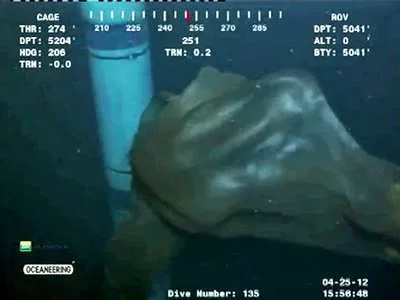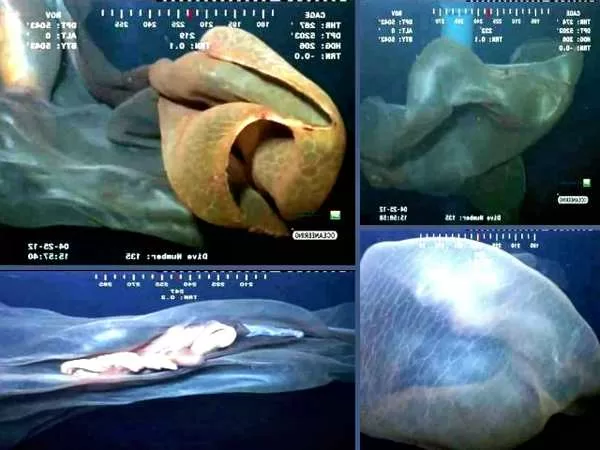Have you ever seen a deep-sea video so strange it makes you question reality? Enter the “Cascade Creature,” a massive, blobby entity filmed near an underwater drilling site. But fear not, sci-fi fans – this mystery has been unlocked by the power of science!
The Cascade Creature
It all started with a remotely operated vehicle (ROV) capturing footage of a monstrous blob near an underwater drilling operation. The creature, an estimated six meters in size, boasted a brownish, hexagonal-patterned “skin” that sent shivers down viewers’ spines. Unsurprisingly, the video went viral, igniting a frenzy of speculation.
The initial theories were as diverse as the creature itself. Some suggested it was a giant, discarded fishing net. However, closer inspection revealed a network of intricate blood vessels and a texture that screamed “living organism.” This ruled out the artificial origin theory.
Science Steps In: Deepstaria to the Rescue!
Enter the real heroes – marine biologists! Experts like Steven Haddock (Monterey Bay Aquarium Research Institute) and Craig McClain (National Evolutionary Synthesis Center) analyzed the footage and quickly debunked the alien theories (sorry, extraterrestrial enthusiasts!). Their verdict? The Cascade Creature was none other than a Deepstaria enigmatica, a deep-sea jellyfish.

So, what exactly is a Deepstaria enigmatica? Imagine a translucent, bag-like jellyfish – that’s the basic structure. They’re not particularly rare, but their large size makes them an uncommon sight, especially in such an intact state. The swirling currents from the ROV might have contributed to the creature’s seemingly undulating movements, and it might even have turned inside-out during filming.
Decoding the “Web-like Pattern”
The hexagonal pattern on the Deepstaria’s “skin” isn’t some alien technology or a nervous system as some initially thought. It’s actually part of the jellyfish’s digestive system – a network of branching structures that help it process its prey.
Deepstaria: A Creature of the Deep
According to Wikipedia, Deepstaria enigmatica was first described in 1967. These jellyfish boast a wide, thin bell (up to 60 cm) that resembles a flowing sheet or even a “lava lamp” with its movements. Marine Species Identification Portal sheds further light on their habitat, pinpointing them to the South Atlantic Ocean. It also highlights their unique “oral arms” that end in fascinating “hook-shaped organs.”
The Cascade Creature story is a reminder that the deep sea remains a vast and mysterious frontier. But it’s also a testament to the power of scientific inquiry. While the initial theories were sensational, a closer look revealed a fascinating deep-sea dweller – the Deepstaria enigmatica. So, the next time you encounter a strange video online, remember – science is often stranger than fiction, and the real mysteries of the deep are just as captivating!

